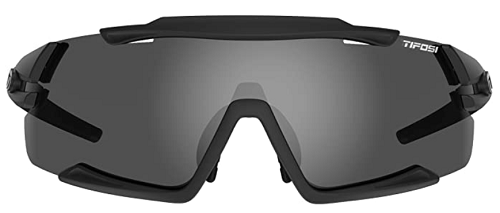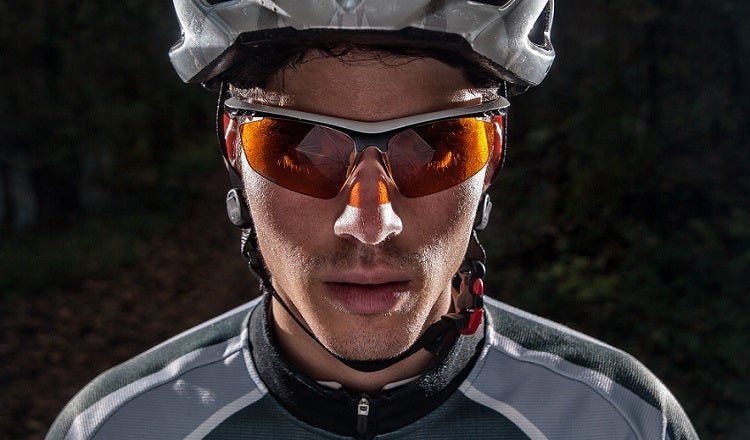
Our Editors independently research, test, and rate what we feel are the best products. We use affiliate links and may receive a small commission on purchases.
Sunglasses are a must-have item for all bikers whether mountain or road biking.
A pair of cycling sunglasses have the important job of protecting a biker from bright sunshine, UV rays, wind, trail debris, low branches, and anything else that you do not want in your eyes.
With the huge choice on offer, knowing which pair of sunglasses to get can be tricky. There are cheap and expensive models with different designs and colors available.
Are the more expensive models better? Will a cheaper pair do the same job?
When it comes to such an important piece of safety equipment, we want to help make a good decision.
Best Cycling Sunglasses
For more of my biking gear recommendations, have a look through these popular Outside Pursuits guide links: MTB Helmets, Road Bike Helmets, Bike Computers.
Quick Answer: The 7 Best Rated Biking Sunglasses For 2021
- Oakley Radar Ev Shield Sport Sunglasses
- POC Crave Sunglasses
- Tifosi Optics Aethon Sunglasses
- adidas Evil Eye Halfrim Pro S Rectangle Sunglasses
- Bolle Diamondback Sunglasses
- Smith Attack MAG MTB ChromaPop Sunglasses
- Under Armour Igniter Sunglasses
Here are my top rated biking glasses with full reviews and our buyers guide below.
Biking Sunglasses Reviews
#1 Oakley Radar Ev Shield Sport Sunglasses
Everyone has heard of Oakley sunglasses. Not everyone likes the styling however, or Oakley’s special names for normal materials.
If you do like the way they look, the Radar Ev Oakley cycling sunglasses are about as good as it gets.
The two scratch-resistant “Plutonite” or polycarbonate lenses that are included have vents to prevent fogging and provide a great field of vision and protection.
They can be swapped out with a large range of other lenses and doing so is a quick and easy job.
The “unobtanium” (rubber) nose clamp can be adjusted to fit your nose and the arms also have rubber coating to prevent any slipping. The frame is made from Oakley’s light and slightly flexible “O Matter” (plastic).
They are not “cheap” but you are paying a fair price for a truly fantastic pair of sunglasses and not just for the fancy material names.
Overall I would say the Radar Ev’s are the best cycling glasses whether you are road or mountain biking.
#2 POC Crave Sunglasses
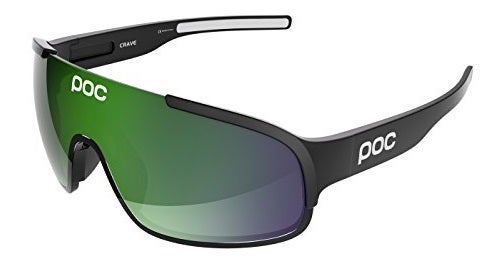 Also a big hitter in terms of price and performance. The Craves have an unbeatable field of vision and a variety of high quality Carl Zeiss lenses are available.
Also a big hitter in terms of price and performance. The Craves have an unbeatable field of vision and a variety of high quality Carl Zeiss lenses are available.
A hydrophobic coating on the lens prevents too much fogging and any rain or muddy blobs of spray from the trail will not hang around long.
The flexible frame runs almost fully around the outside of the lens but does not get in the way of your vision. Rubber on the slim, detachable arms and nose clamp prevent slipping.
The latter is not adjustable so may not fit odd shaped noses but it is soft and comfortable.
I would say the POC Crave’s are the best MTB sunglasses. If you are looking for POC sunglasses that are polarized, take a look at the POC Sports.
#3 Tifosi Optics Aethon Sunglasses
Sometimes you’re cycling in the heat or pushing hard to build your strength and speed. During those times, you’ll appreciate the Aethon brow bar designed to keep your sweat out of your eyes.
But at other times, you can remove the brow bar from your Tifosi Optics Aethon Sunglasses to enjoy that wonderful lightweight feel of half-frame sunglasses.
The lenses are vented to help keep you cool and prevent fogging.
The Grilamid TR-90 frame is surprisingly durable, made from homopolyamide nylon that resists bending.
On top of all of this, Tifosi Optics Aethon Sunglasses come at a crazy low price and in my opinion represent the best budget cycling sunglasses.
#4 adidas Evil Eye Halfrim Pro S Rectangle Sunglasses
Another great pair of road bike sunglasses when it comes to fit and protection. These glasses are available in three sizes and each can be customized, so you are almost guaranteed to be able to find a pair that fits.
Your eyes are very well protected by the large replaceable lenses. There are 20 (yes that many) different lenses available (not included) with a variety of colors and tones on offer.
Swapping the lenses takes a bit of practice but it is no problem once you have got the hang of it.
#5 Bolle King Sunglasses
Not everyone can afford to pay for premium mountain bike glasses. That is where the Bolle King come in but you will be making a couple of compromises.
The rubber finish keeps them in place and the large anti-fog and anti-scratch lenses provide reasonable vision and comfort.
These MTB glasses even look good enough (or “normal” enough) not to look out of place when you are not on your bike.
The main drawback to the Diamondbacks is that the frame has a tendency to collect sweat, but this isn’t a problem for all riders. It just depends on the shape of your face if it’s going to be a problem.
The frame is very sturdy however and makes them ideal for MTB riding. So give them a go if you do not want to pay top dollar.
#6 Smith Attack MAG MTB ChromaPop Sunglasses
The Smith Attack MAG MTB ChromaPop Sunglasses come with a proprietary quick-release system enabling you to effortlessly swap the ChromaPop lenses.
You won’t need to worry about these sunglasses slipping when the sweat begins to pour. The hydrophilic megol temples and nose pads are designed to grip better when wet.
The nose pads are adjustable so you can customize their position for different nose shapes. You can also decrease fogging and increase ventilation by adjusting the position of the sunglasses using the nose pads.
The shield frame shape is aesthetically pleasing. In addition, this design provides you with a large field of unobstructed vision.
You’ll look professional on your cycle wearing Smith Attack MAG MTB ChromaPop Sunglasses.
#7 Under Armour Igniter Sunglasses
The polycarbonate lenses of Under Armour Igniter Sunglasses reduce glare and enable you to perceive true colors.
The lenses are designed to provide you with excellent peripheral vision. The Multiflection lens coating is resistant against staining, smudging, and scratching. It also repels water.
The 3-point nose pad enables you to comfortably fit these sunglasses to any nose shape.
Under Armour Igniter Sunglasses are more affordable than some of the other sunglasses in this review and they are highly rated by customers.
If you’re looking for cycling sunglasses on a budget, these are a great choice.
Cycling Sunglasses Comparison Table
| Ccycling Sunglasses | Polarized | Lens | Frame | UV Protection | Rating | |
|---|---|---|---|---|---|---|
| Oakley Radar Ev Shield Sunglasses | Available | 580 Polycarbonate | Nylon | 100% UVA, UVB & UVC | 4.4 / 5.0 | |
| POC Crave Sunglasses | Yes | Polycarbonate lens | Grilamid nylon | 100% UVA, UVB & UVC | 4.5 / 5.0 | |
| Tifosi Optics Aethon Sunglasses | No | Shatterproof Polycarbonate lens | Grilamid TR-90 nylon | 100% UVA, UVB & UVC | 4.6 / 5.0 | |
| adidas Evil Eye Halfrim Pro | No | Polycarbonate lens | Resin | 100% UVA, UVB & UVC | 4.6 / 5.0 | |
| Bolle King Sunglasses | No | Polycarbonate lenses with Carbo Glass Coating | Nylon | 100% UVA, UVB & UVC, blue light | 4.4 / 5.0 | |
| Smith Attack MAG MTB ChromaPop Sunglasses | Available | ChromaPop lenses | Grilamid TR-90 nylon | 100% UVA, UVB & UVC | 4.5 / 5.0 | |
| Under Armour Igniter Sunglasses | No | Polycarbonate lens | Plastic | 100% UVA, UVB & UVC | 4.6 / 5.0 |
How to Choose the Best Cycling Sunglasses
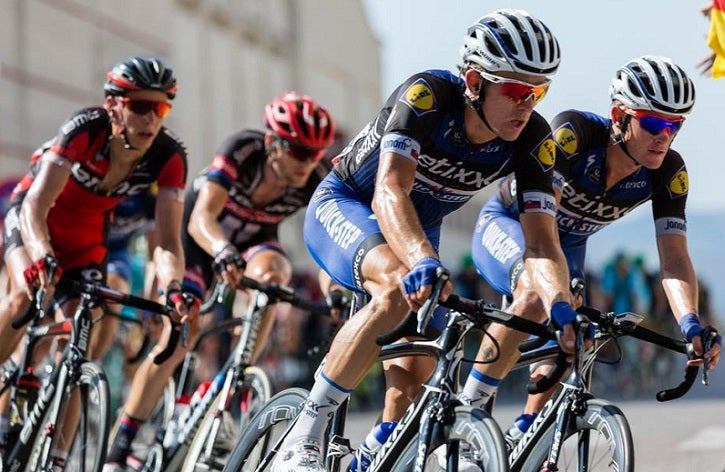
This guide aims to let you know what to look out for and give you the information you need to keep your eyes safe when you are riding.
Fit
It may sound obvious, but even the most expensive, high tech pair of biking sunglasses will be useless if they do not fit you properly. If they are too big or wide, they will fall off your face as soon as you hit rough terrain.
Glasses that are too small will not provide sufficient eye coverage. If they sit too close or make contact with your face, they will steam up in winter and collect sweat streaks in summer.
Although we always try to advise you as best as possible, the fit of a pair of sunglasses is something so personal that you simply have to try a pair on and see if they fit your unique face shape.
As a general rule, there needs to be 4-5mm between the lenses and your face, as well as between the arms and your temples.
Grip
Rubber detailing on the arms and nose clamp secure sunglasses to your face. Without this detailing, they can slip off easier especially once you start sweating.
Polarized vs Non Polarized
When lenses are polarized they automatically filter horizontal reflected glare. This is what causes the strange effects when looking down a long straight road in bright sunlight. The polarizing of the lenses blocks this glare and provides a crisper image.
For this reason having polarized lenses is much more important for road bike riders than for MTB riders. There is no downside to having this feature for MTB riders however.
If you do both types of riding, you may as well get biking glasses that have polarized lenses. The small increased cost is worth it.
Another benefit to polarized lenses is they automatically block UVA and UVB ultra violet light. Of course non polarized lenses can block them as well. In fact you will have a difficult time finding sunglasses nowadays that don’t block at least UVA and UVB rays.
The only “downside” of having polarized lenses is that it is more difficult to read LCD screens of phones or GPS devices.
Lenses
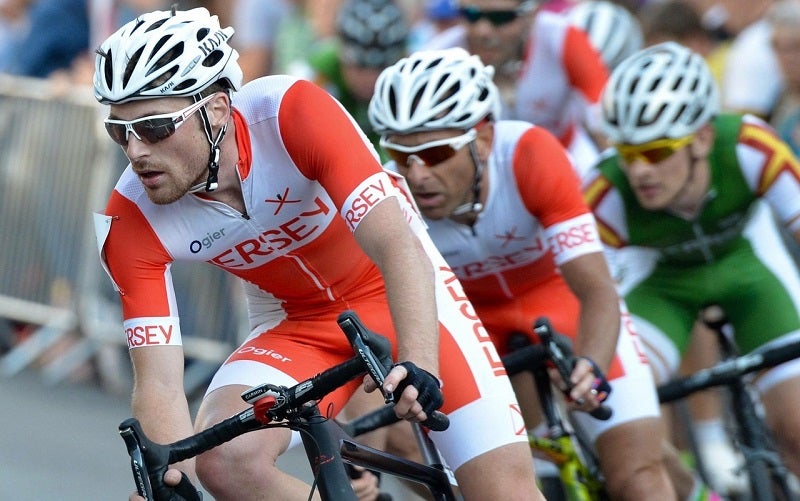
The lenses need to be large enough and wrap around the sides of your face to protect you as much as possible from debris and wind. This kind of lens will also give you the best field of vision. Make sure that the nose clamps or frame do not obstruct your vision.
In winter, you will be best off with a clear lens. In summer, choose a tinted but light lens.
A dark lens will make it hard to see detail in patches of shadow, whereas a colored lens will highlight these, while allowing you to see easily in bright sunshine.
Some lenses make the borders of objects pop out, giving you razor sharp vision.
Photochromic lenses react to the light conditions, getting darker when you enter sunshine and lighter when you enter shade.
If you want this feature, then you really should commit to getting a good pair at a higher price. Cheaper models take longer to react, which does not help you at all.
You want road cycling sunglasses with UV protection.
Fortunately this is a usually a standard with all sunglasses and the UV protection rating will be available either in the product details or from the manufacturer.
The best biking sunglasses have interchangeable lenses but this does not automatically mean that they will come with spares or alternatives. You may have to pay more to get a different tint, but this is certainly cheaper than buying two or more pairs of sunglasses.
Do not be fooled too much by manufacturers claiming that their lenses will not fog up. On a tough climb mid winter, you will find that every pair of sunglasses will get foggy.
Unless you live in a location that’s mostly sunny, you may run into some rain while you’re cycling. Make sure then, that your lenses have a hydrophobic coating.
The coating will ensure the rain drops roll off of the lenses, rather than sticking to them and affecting your vision. Combine these with a quality cycling cap, and you’re all set for rainy weather.
In addition, make sure they have an anti-scratch coating as they’re most likely going to fall on the ground or get dropped at some point.
Full or Half Frame
Half frame glasses usually give you a better field of vision, whereas half frame designs are more robust. It is usually easier to change the lens on half frame glasses.
The best full frame sunglasses will not obstruct your vision at all and tend to be sturdier and be able to take more abuse and a better choice for mountain biking sunglasses.
In additon the the style of frame, another big factor is airflow around the lenses. The more airflow means less fogging and better vision and you won’t need to stop and wipe off the lenses in the hot weather.
How the frame fits your face is of course a personal matter and you may need to try several pairs to find one that is comfortable on your face.
You could even go with frameless sunglasses if you wanted to. These will eliminate the issue of the arms being too tight or loose against your head.
They’re also usually more lightweight. What you’ll need to pay more attention to, is the nosepiece. Most will be able to be adjusted and shaped to fit your nose properly..
Shock Proof
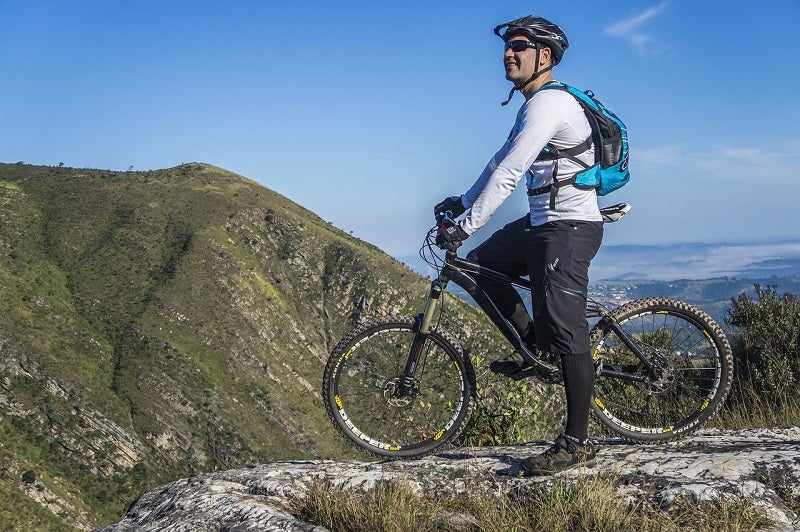
If you crash, you do not want your sunglasses to break for two good reasons. The first is that you probably spent a fair bit of money on them.
The second, more important reason is that if they do break, you run the risk of sharp pieces stabbing you in the face or eyes. Likewise, a quality pair of sunglasses will have a shatterproof lens, which will not break into pieces.
Sunglasses are prone to being sat on, so a pair that are slightly flexible will last longer in the hands (or pockets) of a clumsy rider.
Prescription Lenses
For those of us with less than perfect vision and wear glasses you will want to consider cycling glasses that can be fitted with prescription lenses. The Adidas Evil Eye is a good choice if you want to go that route.
Many riders prefer to wear contacts because of the added cost of having the sunglasses fitted with prescription lenses. Another option are “inserts”, these are prescription lenses that sit in between your eyes and the sunglasses.
This adds to the weight as you essentially have two pairs of glasses then. However, it is s cheaper option and you will have more choices of sunglasses.
Tips for Taking Caring of Your Sunglasses
#1: Simply clean glasses with hand soap and lukewarm water.
The lenses on your glasses are very sensitive to some cleaning agents and can be damaged due to the pH value of some of them. Make sure the water you use is neither too cold nor too warm as this can affect the integrity of the glasses.
#2: Use the right cloth to clean them, too.
Especially when you’re out cycling, and you’re tempted to just rub off a dirty smudge with the hem of your jacket or shirt. Don’t do this unless you have a garment with a special cleaning cloth sewn in that’s made for this purpose. It can actually end up scratching your lenses if you’re not careful. Little pieces of dust and dirt can also do this once you start rubbing the cloth on it.
#3: Keep them safe and protected.
Chances are a good portion of you reading this are looking for new cycling sunglasses because your last ones either got broken or lost. In the rear pockets of cycling jerseys, these things magically get broken.
Most of the glasses listed above are going to come with some kind of pouch or bag to keep them in, which is the ideal place to store them. If you take them off while riding, place them backward on your neck.
#4: If cycling in heavily-forested areas, make sure you have photochromic lenses.
They’ll start to get darker when ambient light is more forceful, and lighter when it’s darker.
FAQ For Cycling Sunglasses
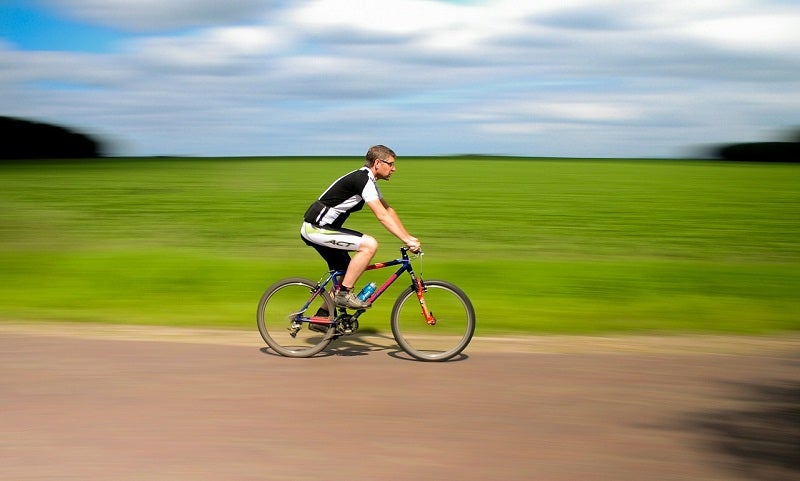
Q: What are polarized sunglasses?
A: Polarized lenses in sunglasses have a chemical treatment that reduces glare. Glare is when light is reflected off a solid surface or water. The treatment neutralizes this glare resulting in being able to see more clearly while reducing harmful UV rays.
Q: What are the benefits of polarized sunglasses?
A: Polarized lenses give you increased visibility and comfort by blocking blinding glare. Your vision is improved in bright sunlight and they increase contrast for enhanced visibility.
Q: Are Polarized lenses worth it?
A: Short answer: YES! Glare is not only a nuisance, it decreases your depth perception and distorts colors. Having better visibility will of course increase your riding safety. There is no reason not to wear sunglasses with polarized lenses.
Q: How does a photochromic lens work?
A: Also known as transition lenses, there are special dyes in the lenses that react and darken when exposed to UV rays. How dark they get varies on the intensity of UV rays.
Q: What do photochromic lenses look like indoors?
A: They’re going to be completely clear – just like regular glasses.
Q: What are the benefits of photochromic lenses?
A: They can provide greater comfort and visibility in one pair of sunglasses. They can reduce glare and eye strain while providing UV protection.
Q: What is UV 100 protection?
A: UV 100 protection means the lenses block 100% of the harmful UVA and UVB from the sun. These rays are extremely harmful and it’s important to check and make sure the sunglasses offer 100% UV protection.
Final Thoughts
As mentioned above, fit is key, so this should be your absolute priority. Identify first which style you would like as well as the kind of lens you need. Then you can pick out a variety of sunglasses that fit the criteria and try them all on. The best-fitting pair wins!
How We Researched
To come up with the top cycling sunglasses, we researched a variety of sources for reviews such as CompetitiveCyclist, JensenUSA, REI, EVO along with our own personal experience.
We also consulted online magazines for product research and reviews to get as much unbiased information as we could. To help weed out fake reviews we used Fakespot.com to make sure we only looked at genuine reviews.
With so much quality gear available, we had to narrow it down based on what we felt were the best options were for the price. The author, Richard Bailey has a wide background in mountain biking in a variety of countries, terrain types and bike packing for weeks on end.
The author has decades of experience and is eager to share his knowledge with readers.
To help narrow down the selection he used personal experiences along with recommendations from fellow MTB bikers, bloggers and bike shops.
After extensive research, we came up with our list to help you choose the right one for you.

